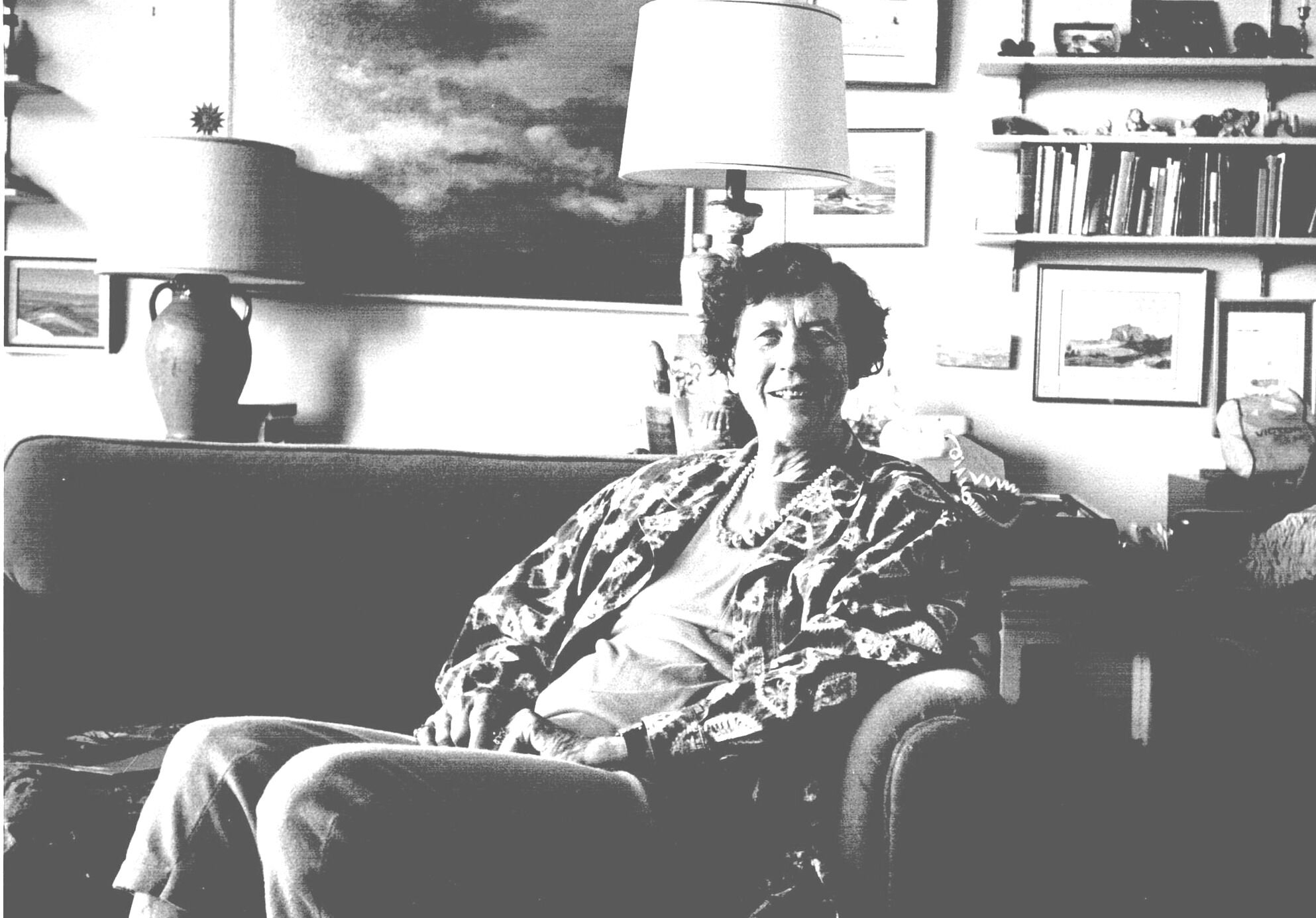By Jan Wahl and Larry Clinton, Sausalito Historical Society
Dorothy Cousins moved to Sausalito in 1954, and lived here for six decades. According to her obituary in 2006, Dorothy was a devoted member of the Sausalito Woman's Club and a founding member of the Sausalito Foundation. She was also one of the founders of Marin Country Day School and served as president of The Tamalpais High School PTA. Dorothy and her husband Ivan were very involved with the Sunny Hills Children's Garden, a group home residential treatment service, and they initiated the Culinary Carnival as a benefit for the organization.
PHOTO FROM SAUSALITO HISTORICAL SOCIETY
Dorothy Cousins at the time of her 1990 oral history
She was frequently visited by her famous sister Julia Child, one of the first celebrity chefs. The Sausalito News of November 25, 1961 reported, “Julia Child has been about town lately visiting her sister, Mrs. Ivan Cousins between times meeting the public at book stores in San Francisco,” while on a promotional tour for the classic cookbook “Mastering the Art of French Cooking."
Julia Child also joined Dorothy and Ivan in fundraising for Children’s Garden. On November 7, 1978
this paper reported on her upcoming appearance at one of these events: “’I’m really looking forward to doing the demonstration and then relaxing and talking to people, enjoying all the food, and shopping for Christmas at all those booths presenting everything to do with food, from frying pans to white truffles,’ said Julia Child in a recent phone conversation with her sister, Dorothy Cousins, of Sausalito who is the co-chairman of the event. Julia Child will do a cooking demonstration at the Culinary Carnival at the Palace of Fine Arts, San Francisco.”
In a 1990 oral history, Dorothy Cousins told Sausalito personality Jan Wahl how she discovered our town in the 1930s, and some of the early impressions it made on her. The following excerpts from that interview have been edited for brevity and clarity:
I was boarding at the Katherine Branson School as a teenager and got to know Sausalito then. Looking out at Mt. Tamalpais, there wasn’t a house there. Marin City didn’t exist except for only a few bungalows. As a matter of fact, when I went to school here, Currey Avenue [where Dorothy was living in 1990] didn’t exist, nor did highway 101 nor did the bridge. And I’m quite sure I hiked over this property. It was country, but the town was always crowded, because in my day there were auto ferries and regular ferries, and people would rush to get on the ferries and sometimes there’d be long lines waiting to get on. Then there was a little electric train that went from Sausalito to Mill Valley, and all the way out to Fairfax. You could get from San Rafael to Sausalito faster than you can now. I wish it were still in use.
Sausalito was off limits for us girls, because it was a very rough town. It was Prohibition. There were a lot of rumrunners and some “ladies of ill repute.” We weren’t allowed anywhere unchaperoned.
We were very innocent in those days. But our French teacher lived here, so we would come to see her and hike all the way to Muir Beach. I just adored being by the water.
In 1954 I moved here with my husband. Because of the Golden Gate Bridge, the ferries had stopped running. The town was smaller, but there were still a lot of tourists on the weekends. Not to the extent of today.
All kinds of people could afford to live here then. A lot of reasonable houses were available. We rented a nice place on Crecienta Drive for $200 a month. Now there’s such high turnover in the police and fire departments because they have no place to live in town.
When I first moved here, the Sausalito school system was a little peculiar. There had been some terrible upsets, and many people had left. And at that time the Marin Country Day School had just started and so my husband and I worked hard on that. And before that there was the Sausalito Co-op nursery school. I didn’t know a soul in Sausalito. But as soon as I joined the nursery school, I made most of my friends there because we cooperated together.
There was a terrible fight about the Spinnaker. That area was the only beach and we’d all go down there with the kids. Then the City Council sold it to somebody, and they put up all this riprap on the beach and nobody was allowed on it, and there was a real row about that. At that point the Council was meeting downtown, but the meeting was so big they had to move it to the school where City Hall is now. At least 200-250 people came out and some were yelling, “You’re selling our birthright!” And you know what happened? The whole council was not re-elected. However, the Spinnaker was a fait accompli.
In the oral history, Dorothy goes on to share her impressions of town characters like Juanita Musson and Sally Stanford. She recalls her husband Ivan’s antique store on Caledonia Street, and many other memories. The entire interview can be heard via the Historical Society website: http://www.sausalitohistoricalsociety.com.

